|
|
|
Sort Order |
|
|
|
Items / Page
|
|
|
|
|
|
|
| Srl | Item |
| 1 |
ID:
115287
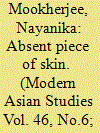

|
|
|
|
|
| Publication |
2012.
|
| Summary/Abstract |
This paper addresses how the wombs of women and the absent skin on the circumcised penises of men become the predominant sites on which racialized and gendered discourses operating during the Bangladesh War are inscribed. This is explored by examining instances of sexual violence by Pakistani soldiers and their local Bengali collaborators. The prevalence of these discourses in colonial documents about the Bengali Muslims underscores the role of history, the politics of identity and in the process, establishes its link with the rapes of Bangladeshi women and men. Through this, the relationship between sexual violence and historical contexts is highlighted. I locate the accounts of male violations by the West Pakistani army within the historical and colonial discourses relating to the construction of the Bengali Muslim and its intertextual, contemporary citational references in photographs and interviews.
I draw on Judith Butler's and Marilyn Strathern's work on gendering and performativity to address the citational role of various practices of discourses of gender and race within colonial documents and its application in a newer context of colonization and sexual violence of women and men during wars. The role of photographs and image-making is intrinsic to these practices. The open semiotic of the photographs allows an exploration of the territorial identities within these images and leads to traces of the silence relating to male violations. Through an examination of the silence surrounding male sexual violence vis-à-vis the emphasis on the rape of women in independent Bangladesh, it is argued that these racialized and gendered discourses are intricately associated to the link between sexuality and the state in relation to masculinity.
|
|
|
|
|
|
|
|
|
|
|
|
|
|
|
|
| 2 |
ID:
115285
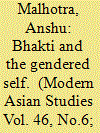

|
|
|
|
|
| Publication |
2012.
|
| Summary/Abstract |
Bhakti is viewed as a movement that is subversive of orthodoxy, and inverts the societal norms prescribed by the dharmashastras. This paper looks at the Bhakti movement's long history and transformations into the nineteenth century in Punjab. If womanly dharma within the normative tradition is defined by sexual containment through marriage and wifehood, the accumulated Bhakti legends and hagiographies are examined to see the place of the prostitute in it, and the limits of its revolutionary potential are brought to the fore. By looking at the writings of the Muslim prostitute Piro who comes to live in the establishment of a 'Sikh' guru Gulab Das, in Chathianwala near Lahore during the period of Ranjit Singh, this paper attempts to read Piro's use of Bhakti legends and imagery to build support for her unusual step. The imbrication of the Gulabdasis in hybrid practices that borrowed elements from advaita, Bhakti and Sufi theologies is also delineated. The paper shows Piro's engagement with the radical potential of Bhakti, but also maps her move towards social conformity-the paradox that makes her look at herself simultaneously as a courtesan and as a consort.
|
|
|
|
|
|
|
|
|
|
|
|
|
|
|
|
| 3 |
ID:
115288
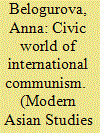

|
|
|
|
|
| Publication |
2012.
|
| Summary/Abstract |
The short history of the Taiwanese Communist Party (Taiwan gongchandang ? ? ? ? ?) (1928-1931) offers a window into the negotiative polity of international communism during the Third Period (1928-1934). The Party was established during the time when the Comintern intensified its operations in colonies and promoted the organization of communist parties there. Its demise was the result of government suppression that occurred as a reaction to their increased public activity in 1931, allegedly at the direction of the Comintern. This paper examines the Comintern's role in the Taiwanese communist movement and shows that the Taiwanese communists were active agents (rather than passive tools) in their relationship with the Comintern.
|
|
|
|
|
|
|
|
|
|
|
|
|
|
|
|
| 4 |
ID:
115292
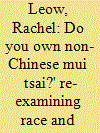

|
|
|
|
|
| Publication |
2012.
|
| Summary/Abstract |
This paper considers the abolition of the mui tsai (young female bondservants) as it unfolded in British Malaya, and challenges the overemphasis on Hong Kong as the primary focus of mui tsai scholarship. While the mui tsai system was defended as a time-honoured Chinese tradition, this paper uses new material to show that trans-racial considerations figured prominently in mui tsai abolition in Malaya, particularly in helping to recast it as a wider problem of child welfare. It is argued that this neglected aspect of mui tsai abolition only comes clearly to light in the Malayan case; for only in the intensely multi-racial conditions of peninsular Malaya could the question be asked: 'Do you own non-Chinese mui tsai?'
|
|
|
|
|
|
|
|
|
|
|
|
|
|
|
|
| 5 |
ID:
115289
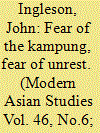

|
|
|
|
|
| Publication |
2012.
|
| Summary/Abstract |
This paper discusses the responses of The Netherlands Indies colonial government to the rise in urban unemployment in Java brought about by the 1930s Depression. At least one in six of the large European/Eurasian population in the colony, and an even larger proportion of urban Indonesian workers, became unemployed as a result of the Depression. The colonial government and the European community were greatly concerned that the growth of unemployment among Europeans would lead to destitution for many, ultimately forcing them into the native kampung1. They were also concerned about what they saw as the moral decay of local-born European/Eurasian youth who were unemployed in unprecedented numbers. Furthermore, the European community feared that the growth in unemployment among western-educated Indonesians in the towns and cities in Java would create a fertile recruitment ground for nationalist political parties leading to urban unrest. Fear of the kampung for destitute Europeans, and fear of urban unrest from unemployed western-educated Indonesians, shaped the colonial government's responses to urban unemployment. The impact of the Depression on both Indonesian and European unemployed in the towns and cities in Java triggered lengthy debates on the role of the state in the provision of social security.
|
|
|
|
|
|
|
|
|
|
|
|
|
|
|
|
| 6 |
ID:
115293


|
|
|
|
|
| Publication |
2012.
|
| Summary/Abstract |
This paper is a study of cultural interaction and diffusion in colonial Bombay. Focusing on Hebrew language instruction, it examines the encounter between India's little-known Bene Israel Jewish community and Protestant missionaries. Whilst eighteenth and nineteenth-century Cochin Jews were responsible for teaching the Bene Israel Jewish liturgy and forms of worship, the Bene Israel acquired Hebrew and Biblical knowledge primarily from nineteenth-century Protestant missionaries. At the beginning of the nineteenth century, the Bene Israel community was a Konkan jati with limited knowledge of Judaism. However, by the end of the century the community had become an Indian-Jewish community roughly analogous to other Jewish communities. This paper explores how this transformation occurred, detailing the content, motivation, and means by which British and American missionaries and, to a lesser extent, Cochin Jews instructed the Bene Israel in Jewish knowledge. Through a critical examination of neglected English and Marathi sources, it reconstructs the Bene Israel perspective in these encounters and their attitude towards the Christian missionaries who laboured amongst them. It demonstrates that the Bene Israel were active participants and selective consumers in their interaction with the missionaries, taking what they wanted most from the encounter: knowledge of the Old Testament and the Hebrew language. Ultimately, the instruction the Bene Israel received from Protestant missionaries did not convert them to Christianity but strengthened and transformed their Judaism.
|
|
|
|
|
|
|
|
|
|
|
|
|
|
|
|
| 7 |
ID:
115286
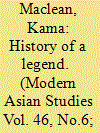

|
|
|
|
|
| Publication |
2012.
|
| Summary/Abstract |
Narratives about the revolutionary movement have largely been the preserve of the popular domain in India, as Christopher Pinney has recently pointed out. India's best-known revolutionary, Bhagat Singh-who was executed by the British in 1931 for his role in the Lahore Conspiracy Case-has been celebrated more in posters, colourful bazaar histories and comic books than in academic tomes. These popular formats have established a hegemonic narrative of his life that has proved to be resistant to subsequent interventions as new materials, such as freshly-declassified intelligence reports and oral history testimonies, come to light. This paper accounts for why Bhagat Singh's life story has predominantly prevailed in the domain of the popular, with special reference to the secrecy of the revolutionary movement and the censure and censorship to which it was subjected in the 1930s.
|
|
|
|
|
|
|
|
|
|
|
|
|
|
|
|
| 8 |
ID:
115291
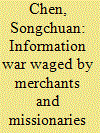

|
|
|
|
|
| Publication |
2012.
|
| Summary/Abstract |
This paper explores the efforts and impact of the Society for the Diffusion of Useful Knowledge in China (1834-1839), which existed during the five years before the First Opium War. It contends that the Society represented a third form of British engagement with the Chinese, alongside the diplomatic attempts of 1793 and 1816, and the military conflict of 1839-1842. The Society waged an 'information war' to penetrate the information barrier that the Qing had established to contain European trade and missions. The foreigners in Canton believed they were barred from further access to China because the Chinese had no information on the true character of the Europeans. Thus, they prepared 'intellectual artillery' in the form of Chinese language publications, especially on world geography, to distribute among the Chinese, in the hope that this effort would familiarize the Chinese with the science and art of Westerners and thereby cultivate respect and a welcoming atmosphere. The war metaphor was conceived, and the information war was waged, in the periphery of the British informal empire in Canton, but it contributed to the conceptualization of war against China, both in Canton and in Britain, in the years before actual military action. Behind the rhetoric of war and knowledge diffusion in Canton, lay a convergence of interests between merchants and missionaries, which drove both to employ information and military power to further their shared aim of opening China up for trade and proselytizing.
|
|
|
|
|
|
|
|
|
|
|
|
|
|
|
|
| 9 |
ID:
115290


|
|
|
|
|
| Publication |
2012.
|
| Summary/Abstract |
Sikh policemen were an indelible part of the landscape of Shanghai in the first decades of the twentieth century, and have left their mark in the ways in which the city is remembered up to the present day. Yet their history has never been told and historians of the period have, at best, simply referred to them in passing. This paper redresses this gap in the literature by accounting for the presence of the Sikh branch of the Shanghai Municipal Police and exploring their role in the governance and policing of the International Settlement. This enriches our understanding of the nature of the British presence in China and the ways in which Indian sub-imperialism extended to China's treaty ports, for on the streets of Shanghai, and not Shanghai alone, British power had an Indian face.
|
|
|
|
|
|
|
|
|
|
|
|
|
|
|
|
| 10 |
ID:
115284
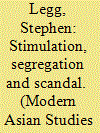

|
|
|
|
|
| Publication |
2012.
|
| Summary/Abstract |
This paper explores the regulation of prostitution in colonial India between the abolition of the Indian Contagious Diseases Act in 1888 and the passing of the first Suppression of Immoral Traffic Act in 1923. It challenges the commonly held assumption that prostitutes naturally segregated themselves in Indian cities, and shows that this was a policy advocated by the Government of India. The object was to prevent the military visiting these segregated areas, in the absence of effective Cantonment Regulations for registering, inspecting, and treating prostitutes. The central government stimulated provincial segregation through expressing its desires via demi-official memoranda and confidential correspondence, to which Rangoon and Bombay responded most willingly. The second half of the paper explores the conditions, in both India and Ceylon, that made these segregated areas into scandalous sites in the early twentieth century. It situates the brothel amongst changing beliefs that they: increased rather than decreased incidents of homosexuality; stimulated trafficking in women and children; and encouraged the spread of scandalous white prostitutes 'up-country', beyond their tolerated location in coastal cosmopolitan ports. Taken alongside demands that the state support social reform in the early twentieth century, segregation provided the tipping point for the shift towards suppression from 1917 onwards. It also illustrates the scalar shifts in which central-local relations, and relations between provinces, in government were being negotiated in advance of the dyarchy system formalized in 1919.
|
|
|
|
|
|
|
|
|
|
|
|
|
|
|
|
|
|
|
|
|